System Vision Document: National University Enrollment System Analysis
VerifiedAdded on 2023/04/11
|12
|2028
|180
Report
AI Summary
This System Vision Document analyzes the enrollment system of the National University of Melbourne. The document begins with an executive summary and an introduction outlining the project's scope: to address issues within the university's manual enrollment procedures by creating a new online system. The report then details the current problems faced by students, such as manual processes and long queues, and proposes a new system with features like online credential gathering, program selection, class selection, payment processing, and final verification. It highlights the system's capabilities, including user-friendly interfaces and automated processes. The document also explores the benefits to the business, such as improved student interfaces and efficient management, along with the necessary hardware, software, and human resources. It includes a stakeholder map and assesses the project's feasibility from technical, economic, legal, and operational perspectives. The conclusion reinforces the system's potential to streamline the enrollment process for both students and the university administration.

Running head: SYSTEM VISION DOCUMENT
System Vision Document
Name of the student:
Name of the university:
Author Note:
System Vision Document
Name of the student:
Name of the university:
Author Note:
Paraphrase This Document
Need a fresh take? Get an instant paraphrase of this document with our AI Paraphraser
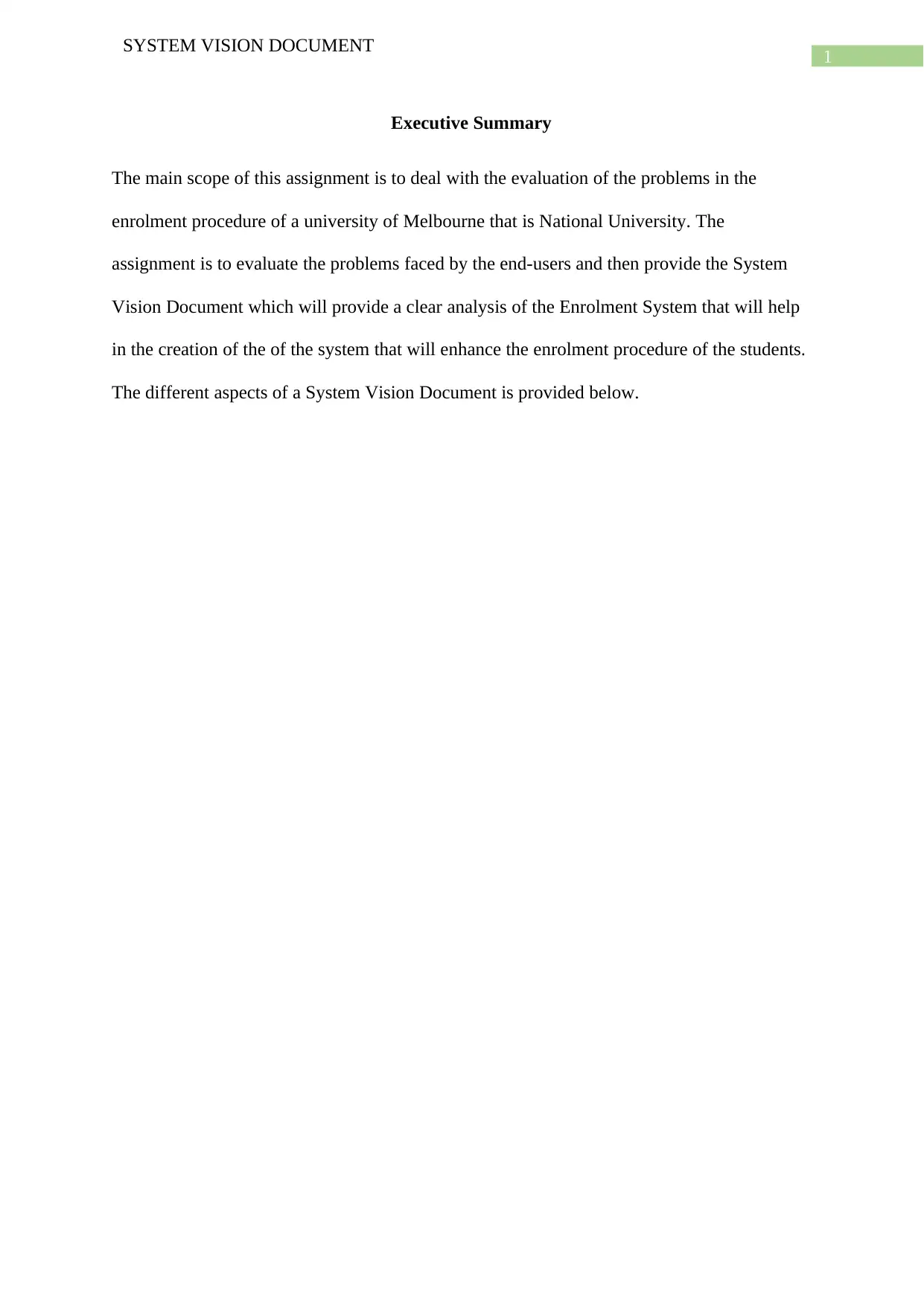
1
SYSTEM VISION DOCUMENT
Executive Summary
The main scope of this assignment is to deal with the evaluation of the problems in the
enrolment procedure of a university of Melbourne that is National University. The
assignment is to evaluate the problems faced by the end-users and then provide the System
Vision Document which will provide a clear analysis of the Enrolment System that will help
in the creation of the of the system that will enhance the enrolment procedure of the students.
The different aspects of a System Vision Document is provided below.
SYSTEM VISION DOCUMENT
Executive Summary
The main scope of this assignment is to deal with the evaluation of the problems in the
enrolment procedure of a university of Melbourne that is National University. The
assignment is to evaluate the problems faced by the end-users and then provide the System
Vision Document which will provide a clear analysis of the Enrolment System that will help
in the creation of the of the system that will enhance the enrolment procedure of the students.
The different aspects of a System Vision Document is provided below.
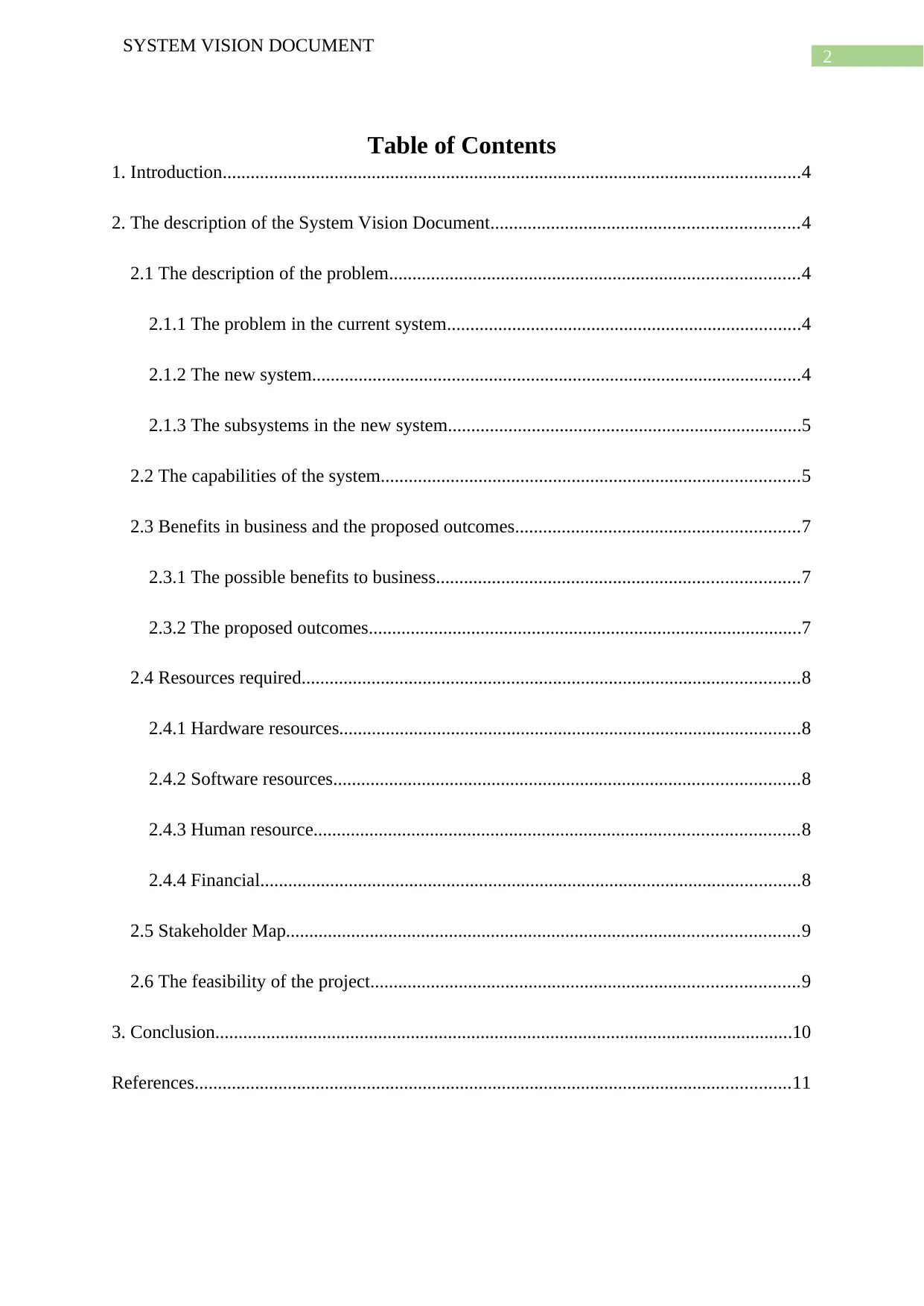
2
SYSTEM VISION DOCUMENT
Table of Contents
1. Introduction............................................................................................................................4
2. The description of the System Vision Document..................................................................4
2.1 The description of the problem........................................................................................4
2.1.1 The problem in the current system............................................................................4
2.1.2 The new system.........................................................................................................4
2.1.3 The subsystems in the new system............................................................................5
2.2 The capabilities of the system..........................................................................................5
2.3 Benefits in business and the proposed outcomes.............................................................7
2.3.1 The possible benefits to business..............................................................................7
2.3.2 The proposed outcomes.............................................................................................7
2.4 Resources required...........................................................................................................8
2.4.1 Hardware resources...................................................................................................8
2.4.2 Software resources....................................................................................................8
2.4.3 Human resource........................................................................................................8
2.4.4 Financial....................................................................................................................8
2.5 Stakeholder Map..............................................................................................................9
2.6 The feasibility of the project............................................................................................9
3. Conclusion............................................................................................................................10
References................................................................................................................................11
SYSTEM VISION DOCUMENT
Table of Contents
1. Introduction............................................................................................................................4
2. The description of the System Vision Document..................................................................4
2.1 The description of the problem........................................................................................4
2.1.1 The problem in the current system............................................................................4
2.1.2 The new system.........................................................................................................4
2.1.3 The subsystems in the new system............................................................................5
2.2 The capabilities of the system..........................................................................................5
2.3 Benefits in business and the proposed outcomes.............................................................7
2.3.1 The possible benefits to business..............................................................................7
2.3.2 The proposed outcomes.............................................................................................7
2.4 Resources required...........................................................................................................8
2.4.1 Hardware resources...................................................................................................8
2.4.2 Software resources....................................................................................................8
2.4.3 Human resource........................................................................................................8
2.4.4 Financial....................................................................................................................8
2.5 Stakeholder Map..............................................................................................................9
2.6 The feasibility of the project............................................................................................9
3. Conclusion............................................................................................................................10
References................................................................................................................................11
⊘ This is a preview!⊘
Do you want full access?
Subscribe today to unlock all pages.

Trusted by 1+ million students worldwide
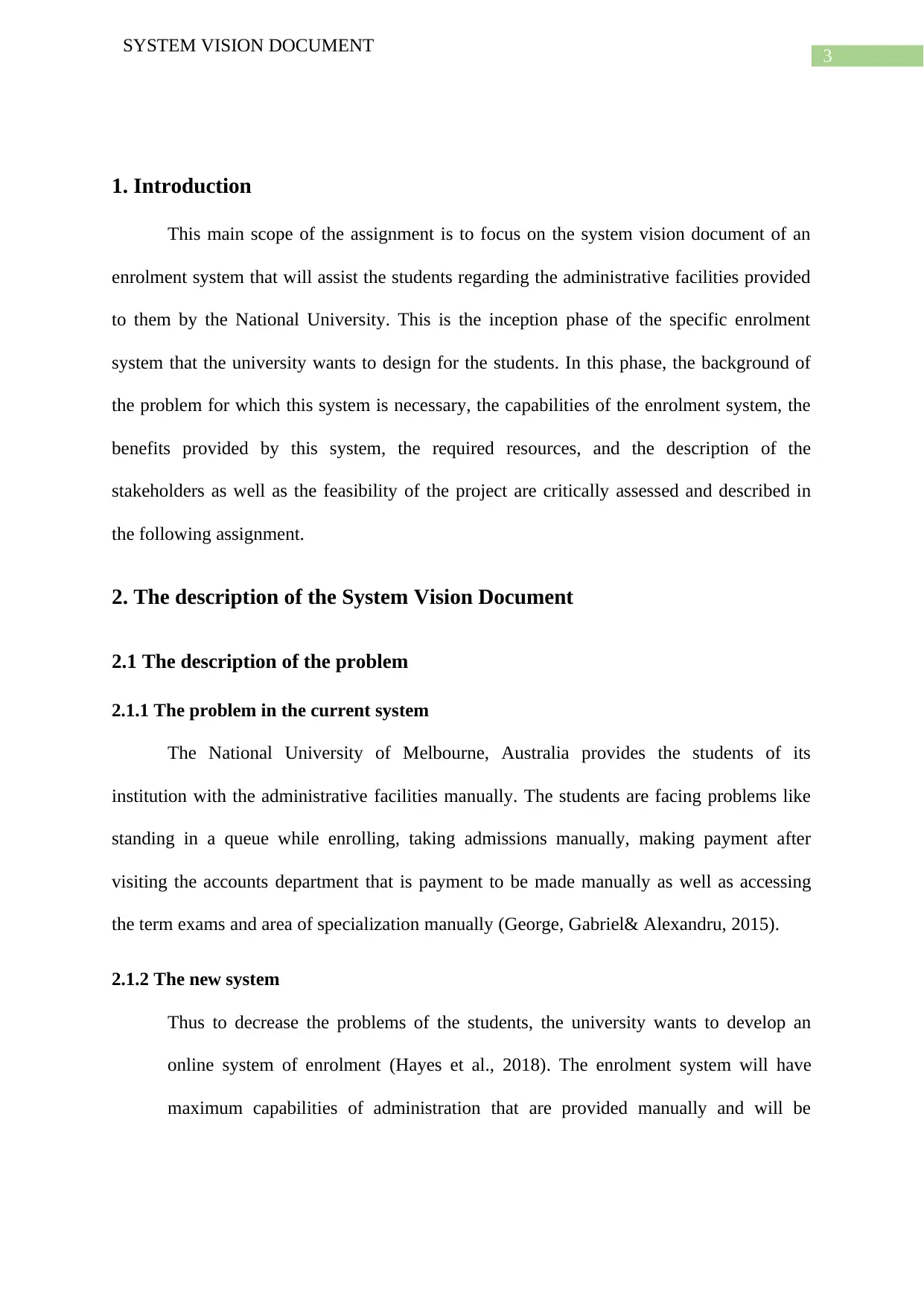
3
SYSTEM VISION DOCUMENT
1. Introduction
This main scope of the assignment is to focus on the system vision document of an
enrolment system that will assist the students regarding the administrative facilities provided
to them by the National University. This is the inception phase of the specific enrolment
system that the university wants to design for the students. In this phase, the background of
the problem for which this system is necessary, the capabilities of the enrolment system, the
benefits provided by this system, the required resources, and the description of the
stakeholders as well as the feasibility of the project are critically assessed and described in
the following assignment.
2. The description of the System Vision Document
2.1 The description of the problem
2.1.1 The problem in the current system
The National University of Melbourne, Australia provides the students of its
institution with the administrative facilities manually. The students are facing problems like
standing in a queue while enrolling, taking admissions manually, making payment after
visiting the accounts department that is payment to be made manually as well as accessing
the term exams and area of specialization manually (George, Gabriel& Alexandru, 2015).
2.1.2 The new system
Thus to decrease the problems of the students, the university wants to develop an
online system of enrolment (Hayes et al., 2018). The enrolment system will have
maximum capabilities of administration that are provided manually and will be
SYSTEM VISION DOCUMENT
1. Introduction
This main scope of the assignment is to focus on the system vision document of an
enrolment system that will assist the students regarding the administrative facilities provided
to them by the National University. This is the inception phase of the specific enrolment
system that the university wants to design for the students. In this phase, the background of
the problem for which this system is necessary, the capabilities of the enrolment system, the
benefits provided by this system, the required resources, and the description of the
stakeholders as well as the feasibility of the project are critically assessed and described in
the following assignment.
2. The description of the System Vision Document
2.1 The description of the problem
2.1.1 The problem in the current system
The National University of Melbourne, Australia provides the students of its
institution with the administrative facilities manually. The students are facing problems like
standing in a queue while enrolling, taking admissions manually, making payment after
visiting the accounts department that is payment to be made manually as well as accessing
the term exams and area of specialization manually (George, Gabriel& Alexandru, 2015).
2.1.2 The new system
Thus to decrease the problems of the students, the university wants to develop an
online system of enrolment (Hayes et al., 2018). The enrolment system will have
maximum capabilities of administration that are provided manually and will be
Paraphrase This Document
Need a fresh take? Get an instant paraphrase of this document with our AI Paraphraser
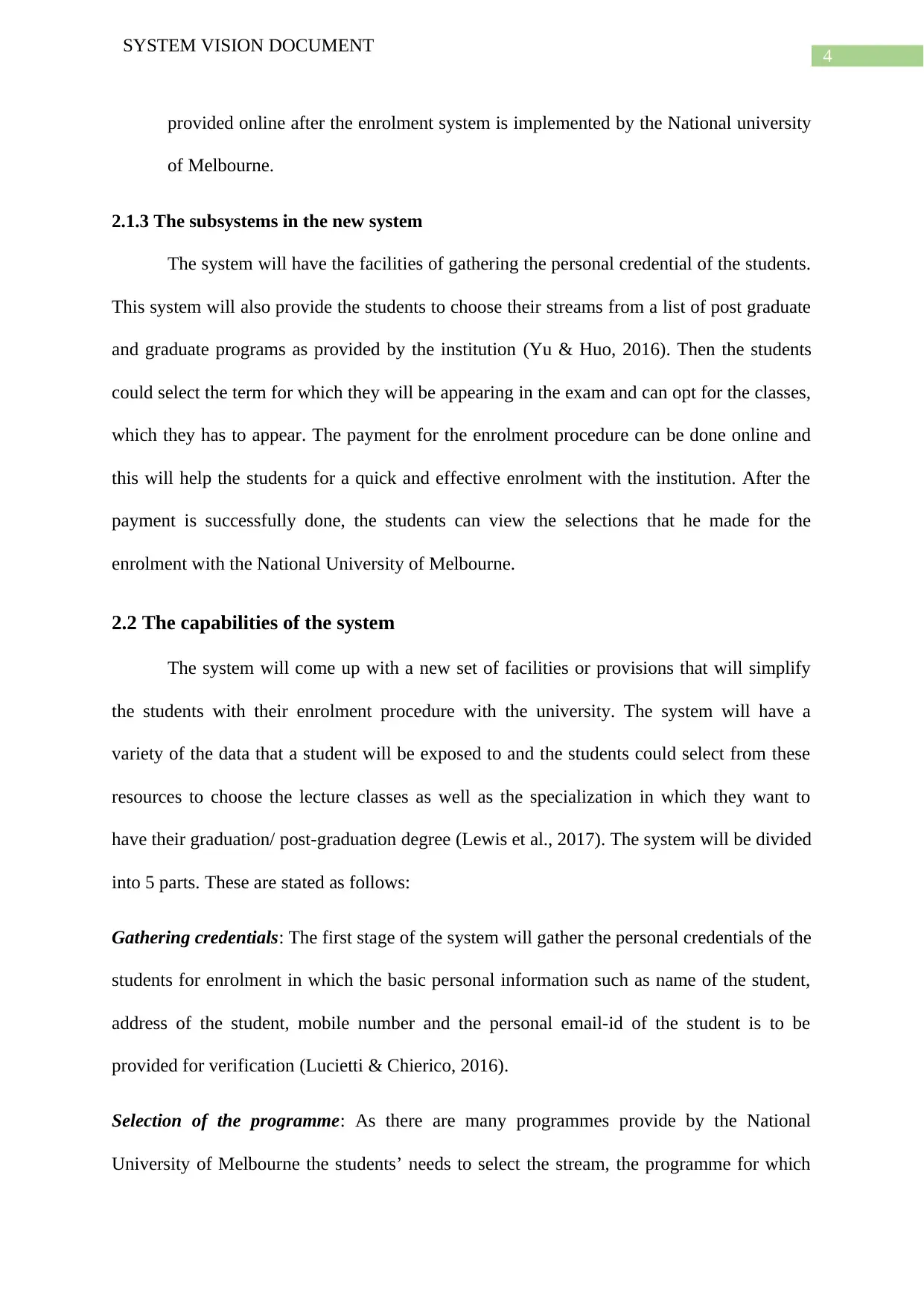
4
SYSTEM VISION DOCUMENT
provided online after the enrolment system is implemented by the National university
of Melbourne.
2.1.3 The subsystems in the new system
The system will have the facilities of gathering the personal credential of the students.
This system will also provide the students to choose their streams from a list of post graduate
and graduate programs as provided by the institution (Yu & Huo, 2016). Then the students
could select the term for which they will be appearing in the exam and can opt for the classes,
which they has to appear. The payment for the enrolment procedure can be done online and
this will help the students for a quick and effective enrolment with the institution. After the
payment is successfully done, the students can view the selections that he made for the
enrolment with the National University of Melbourne.
2.2 The capabilities of the system
The system will come up with a new set of facilities or provisions that will simplify
the students with their enrolment procedure with the university. The system will have a
variety of the data that a student will be exposed to and the students could select from these
resources to choose the lecture classes as well as the specialization in which they want to
have their graduation/ post-graduation degree (Lewis et al., 2017). The system will be divided
into 5 parts. These are stated as follows:
Gathering credentials: The first stage of the system will gather the personal credentials of the
students for enrolment in which the basic personal information such as name of the student,
address of the student, mobile number and the personal email-id of the student is to be
provided for verification (Lucietti & Chierico, 2016).
Selection of the programme: As there are many programmes provide by the National
University of Melbourne the students’ needs to select the stream, the programme for which
SYSTEM VISION DOCUMENT
provided online after the enrolment system is implemented by the National university
of Melbourne.
2.1.3 The subsystems in the new system
The system will have the facilities of gathering the personal credential of the students.
This system will also provide the students to choose their streams from a list of post graduate
and graduate programs as provided by the institution (Yu & Huo, 2016). Then the students
could select the term for which they will be appearing in the exam and can opt for the classes,
which they has to appear. The payment for the enrolment procedure can be done online and
this will help the students for a quick and effective enrolment with the institution. After the
payment is successfully done, the students can view the selections that he made for the
enrolment with the National University of Melbourne.
2.2 The capabilities of the system
The system will come up with a new set of facilities or provisions that will simplify
the students with their enrolment procedure with the university. The system will have a
variety of the data that a student will be exposed to and the students could select from these
resources to choose the lecture classes as well as the specialization in which they want to
have their graduation/ post-graduation degree (Lewis et al., 2017). The system will be divided
into 5 parts. These are stated as follows:
Gathering credentials: The first stage of the system will gather the personal credentials of the
students for enrolment in which the basic personal information such as name of the student,
address of the student, mobile number and the personal email-id of the student is to be
provided for verification (Lucietti & Chierico, 2016).
Selection of the programme: As there are many programmes provide by the National
University of Melbourne the students’ needs to select the stream, the programme for which
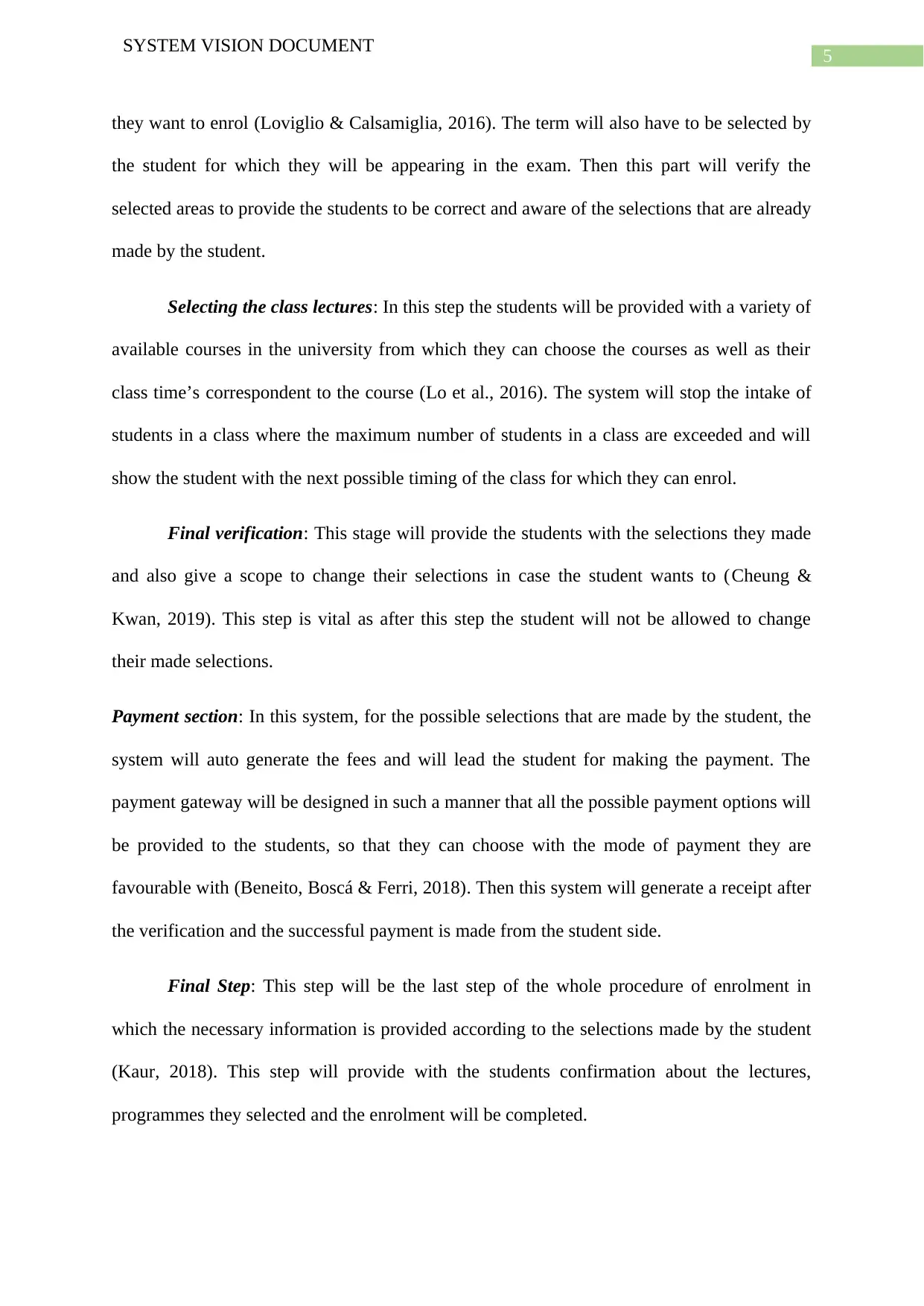
5
SYSTEM VISION DOCUMENT
they want to enrol (Loviglio & Calsamiglia, 2016). The term will also have to be selected by
the student for which they will be appearing in the exam. Then this part will verify the
selected areas to provide the students to be correct and aware of the selections that are already
made by the student.
Selecting the class lectures: In this step the students will be provided with a variety of
available courses in the university from which they can choose the courses as well as their
class time’s correspondent to the course (Lo et al., 2016). The system will stop the intake of
students in a class where the maximum number of students in a class are exceeded and will
show the student with the next possible timing of the class for which they can enrol.
Final verification: This stage will provide the students with the selections they made
and also give a scope to change their selections in case the student wants to (Cheung &
Kwan, 2019). This step is vital as after this step the student will not be allowed to change
their made selections.
Payment section: In this system, for the possible selections that are made by the student, the
system will auto generate the fees and will lead the student for making the payment. The
payment gateway will be designed in such a manner that all the possible payment options will
be provided to the students, so that they can choose with the mode of payment they are
favourable with (Beneito, Boscá & Ferri, 2018). Then this system will generate a receipt after
the verification and the successful payment is made from the student side.
Final Step: This step will be the last step of the whole procedure of enrolment in
which the necessary information is provided according to the selections made by the student
(Kaur, 2018). This step will provide with the students confirmation about the lectures,
programmes they selected and the enrolment will be completed.
SYSTEM VISION DOCUMENT
they want to enrol (Loviglio & Calsamiglia, 2016). The term will also have to be selected by
the student for which they will be appearing in the exam. Then this part will verify the
selected areas to provide the students to be correct and aware of the selections that are already
made by the student.
Selecting the class lectures: In this step the students will be provided with a variety of
available courses in the university from which they can choose the courses as well as their
class time’s correspondent to the course (Lo et al., 2016). The system will stop the intake of
students in a class where the maximum number of students in a class are exceeded and will
show the student with the next possible timing of the class for which they can enrol.
Final verification: This stage will provide the students with the selections they made
and also give a scope to change their selections in case the student wants to (Cheung &
Kwan, 2019). This step is vital as after this step the student will not be allowed to change
their made selections.
Payment section: In this system, for the possible selections that are made by the student, the
system will auto generate the fees and will lead the student for making the payment. The
payment gateway will be designed in such a manner that all the possible payment options will
be provided to the students, so that they can choose with the mode of payment they are
favourable with (Beneito, Boscá & Ferri, 2018). Then this system will generate a receipt after
the verification and the successful payment is made from the student side.
Final Step: This step will be the last step of the whole procedure of enrolment in
which the necessary information is provided according to the selections made by the student
(Kaur, 2018). This step will provide with the students confirmation about the lectures,
programmes they selected and the enrolment will be completed.
⊘ This is a preview!⊘
Do you want full access?
Subscribe today to unlock all pages.

Trusted by 1+ million students worldwide
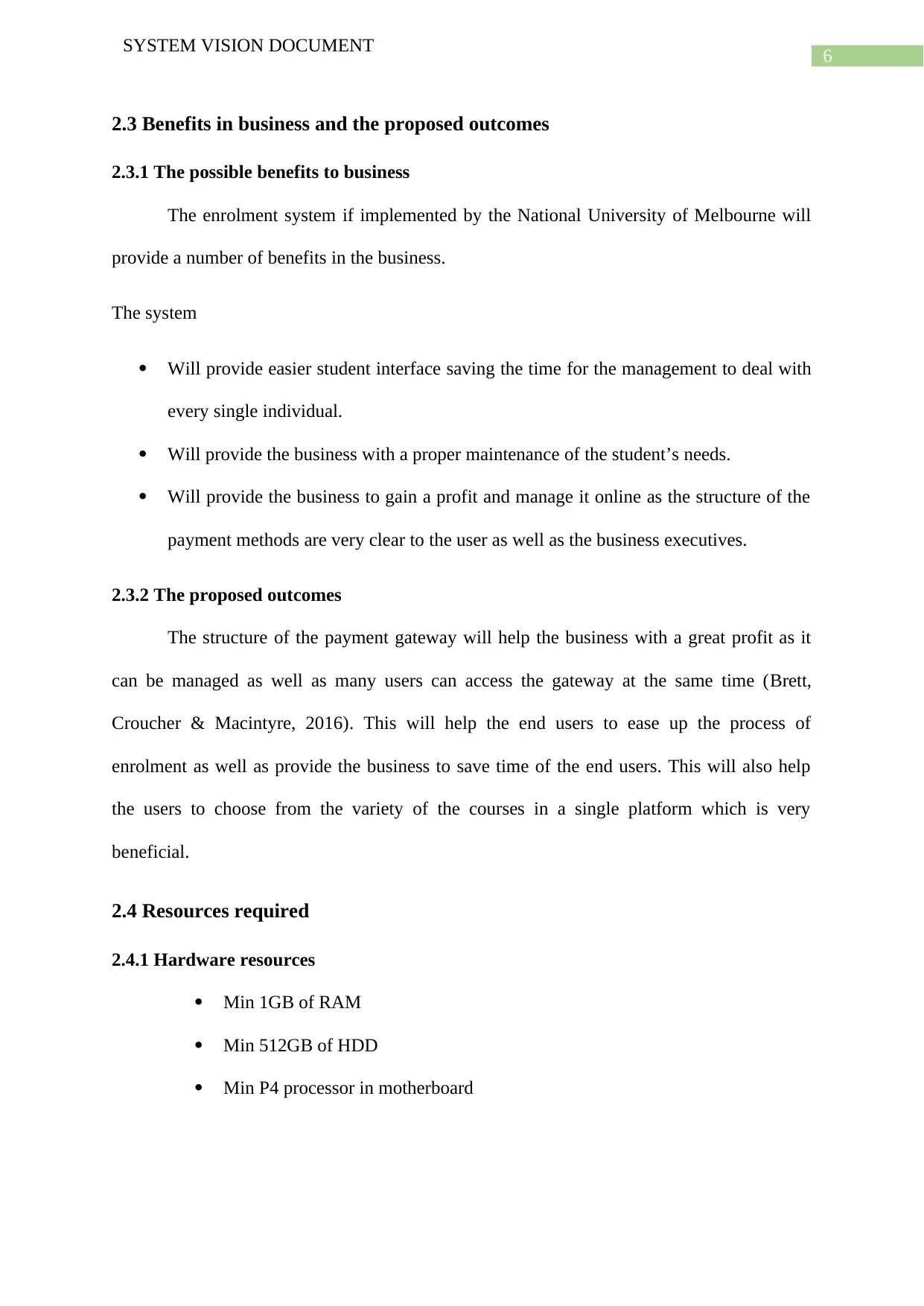
6
SYSTEM VISION DOCUMENT
2.3 Benefits in business and the proposed outcomes
2.3.1 The possible benefits to business
The enrolment system if implemented by the National University of Melbourne will
provide a number of benefits in the business.
The system
Will provide easier student interface saving the time for the management to deal with
every single individual.
Will provide the business with a proper maintenance of the student’s needs.
Will provide the business to gain a profit and manage it online as the structure of the
payment methods are very clear to the user as well as the business executives.
2.3.2 The proposed outcomes
The structure of the payment gateway will help the business with a great profit as it
can be managed as well as many users can access the gateway at the same time (Brett,
Croucher & Macintyre, 2016). This will help the end users to ease up the process of
enrolment as well as provide the business to save time of the end users. This will also help
the users to choose from the variety of the courses in a single platform which is very
beneficial.
2.4 Resources required
2.4.1 Hardware resources
Min 1GB of RAM
Min 512GB of HDD
Min P4 processor in motherboard
SYSTEM VISION DOCUMENT
2.3 Benefits in business and the proposed outcomes
2.3.1 The possible benefits to business
The enrolment system if implemented by the National University of Melbourne will
provide a number of benefits in the business.
The system
Will provide easier student interface saving the time for the management to deal with
every single individual.
Will provide the business with a proper maintenance of the student’s needs.
Will provide the business to gain a profit and manage it online as the structure of the
payment methods are very clear to the user as well as the business executives.
2.3.2 The proposed outcomes
The structure of the payment gateway will help the business with a great profit as it
can be managed as well as many users can access the gateway at the same time (Brett,
Croucher & Macintyre, 2016). This will help the end users to ease up the process of
enrolment as well as provide the business to save time of the end users. This will also help
the users to choose from the variety of the courses in a single platform which is very
beneficial.
2.4 Resources required
2.4.1 Hardware resources
Min 1GB of RAM
Min 512GB of HDD
Min P4 processor in motherboard
Paraphrase This Document
Need a fresh take? Get an instant paraphrase of this document with our AI Paraphraser
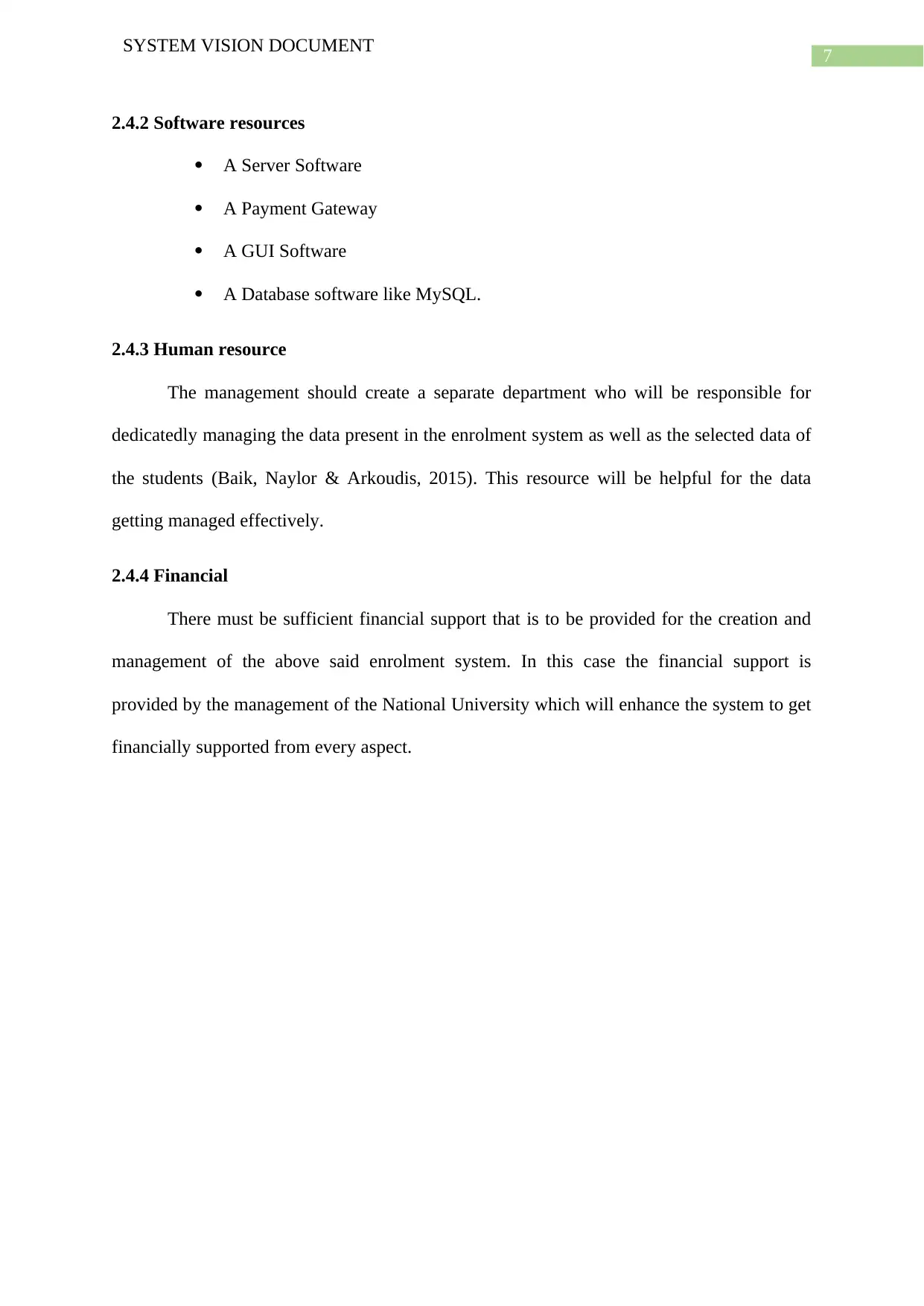
7
SYSTEM VISION DOCUMENT
2.4.2 Software resources
A Server Software
A Payment Gateway
A GUI Software
A Database software like MySQL.
2.4.3 Human resource
The management should create a separate department who will be responsible for
dedicatedly managing the data present in the enrolment system as well as the selected data of
the students (Baik, Naylor & Arkoudis, 2015). This resource will be helpful for the data
getting managed effectively.
2.4.4 Financial
There must be sufficient financial support that is to be provided for the creation and
management of the above said enrolment system. In this case the financial support is
provided by the management of the National University which will enhance the system to get
financially supported from every aspect.
SYSTEM VISION DOCUMENT
2.4.2 Software resources
A Server Software
A Payment Gateway
A GUI Software
A Database software like MySQL.
2.4.3 Human resource
The management should create a separate department who will be responsible for
dedicatedly managing the data present in the enrolment system as well as the selected data of
the students (Baik, Naylor & Arkoudis, 2015). This resource will be helpful for the data
getting managed effectively.
2.4.4 Financial
There must be sufficient financial support that is to be provided for the creation and
management of the above said enrolment system. In this case the financial support is
provided by the management of the National University which will enhance the system to get
financially supported from every aspect.
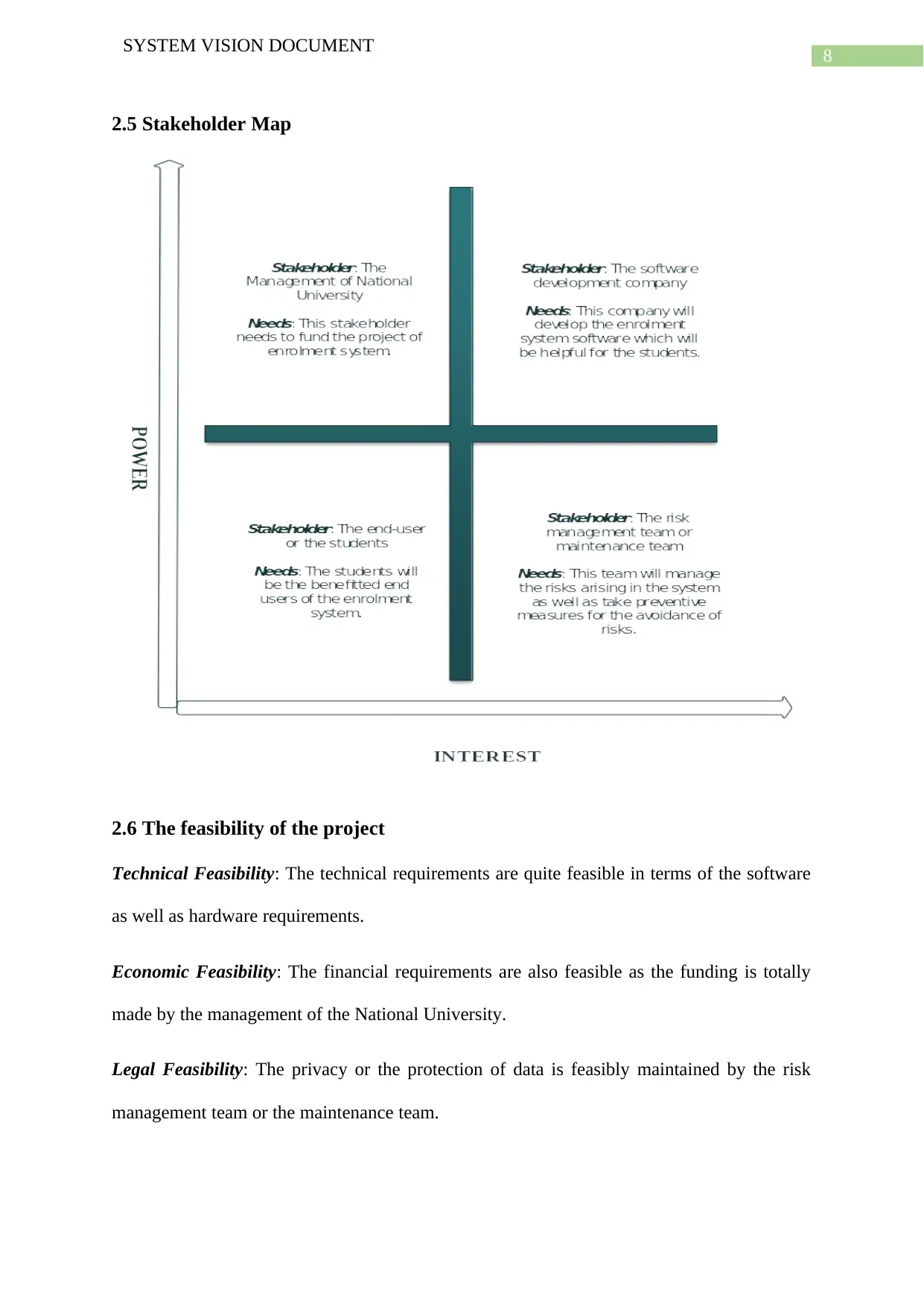
8
SYSTEM VISION DOCUMENT
2.5 Stakeholder Map
2.6 The feasibility of the project
Technical Feasibility: The technical requirements are quite feasible in terms of the software
as well as hardware requirements.
Economic Feasibility: The financial requirements are also feasible as the funding is totally
made by the management of the National University.
Legal Feasibility: The privacy or the protection of data is feasibly maintained by the risk
management team or the maintenance team.
SYSTEM VISION DOCUMENT
2.5 Stakeholder Map
2.6 The feasibility of the project
Technical Feasibility: The technical requirements are quite feasible in terms of the software
as well as hardware requirements.
Economic Feasibility: The financial requirements are also feasible as the funding is totally
made by the management of the National University.
Legal Feasibility: The privacy or the protection of data is feasibly maintained by the risk
management team or the maintenance team.
⊘ This is a preview!⊘
Do you want full access?
Subscribe today to unlock all pages.

Trusted by 1+ million students worldwide
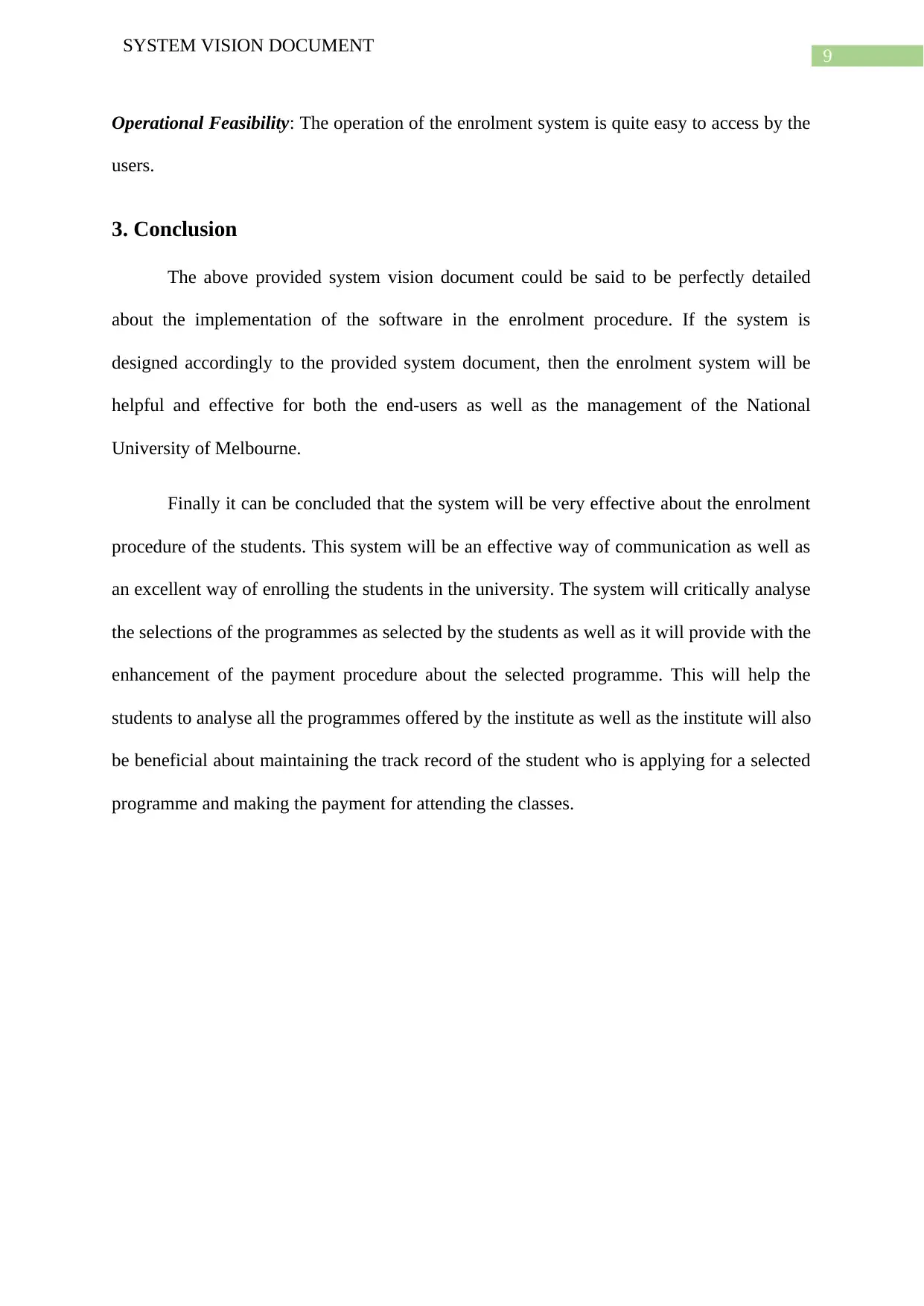
9
SYSTEM VISION DOCUMENT
Operational Feasibility: The operation of the enrolment system is quite easy to access by the
users.
3. Conclusion
The above provided system vision document could be said to be perfectly detailed
about the implementation of the software in the enrolment procedure. If the system is
designed accordingly to the provided system document, then the enrolment system will be
helpful and effective for both the end-users as well as the management of the National
University of Melbourne.
Finally it can be concluded that the system will be very effective about the enrolment
procedure of the students. This system will be an effective way of communication as well as
an excellent way of enrolling the students in the university. The system will critically analyse
the selections of the programmes as selected by the students as well as it will provide with the
enhancement of the payment procedure about the selected programme. This will help the
students to analyse all the programmes offered by the institute as well as the institute will also
be beneficial about maintaining the track record of the student who is applying for a selected
programme and making the payment for attending the classes.
SYSTEM VISION DOCUMENT
Operational Feasibility: The operation of the enrolment system is quite easy to access by the
users.
3. Conclusion
The above provided system vision document could be said to be perfectly detailed
about the implementation of the software in the enrolment procedure. If the system is
designed accordingly to the provided system document, then the enrolment system will be
helpful and effective for both the end-users as well as the management of the National
University of Melbourne.
Finally it can be concluded that the system will be very effective about the enrolment
procedure of the students. This system will be an effective way of communication as well as
an excellent way of enrolling the students in the university. The system will critically analyse
the selections of the programmes as selected by the students as well as it will provide with the
enhancement of the payment procedure about the selected programme. This will help the
students to analyse all the programmes offered by the institute as well as the institute will also
be beneficial about maintaining the track record of the student who is applying for a selected
programme and making the payment for attending the classes.
Paraphrase This Document
Need a fresh take? Get an instant paraphrase of this document with our AI Paraphraser

10
SYSTEM VISION DOCUMENT
References
Baik, C., Naylor, R., & Arkoudis, S. (2015). The First Year Experience in Australian
Universities: Findings from Two Decades, 1994-2014. Melbourne Centre for the
Study of Higher Education.
Beneito, P., Boscá, J. E., & Ferri, J. (2018). Tuition fees and student effort at university.
Economics of Education Review, 64, 114-128.
Brett, A. D., Croucher, G., & Macintyre, S. (2016). Life After Dawkins University of
Melbourne in the Unified National System of Higher Education.
Cheung, E. L., & Kwan, K. P. (2019). Developing an e-Learning Module to Prepare Students
for Service-Learning. In Service-Learning for Youth Leadership (pp. 293-308).
Springer, Singapore.
George, C. R., Gabriel, P. A., & Alexandru, S. E. (2015). Student enrolement management.
case study at the computer science department. Revista Economică, 67(3).
Hayes, B. E., O’Neal, E. N., Meeker, K. A., Steele, S. A., Brady, P. Q., & Bills, M. A.
(2018). Assessing online strategies aimed at enhancing campus safety. Journal of
Aggression, Conflict and Peace Research, 10(2), 112-122.
Kaur, M. (2018). OPTIMIZATION OF SWARM INTELLIGENCE BASED SOLUTIONS
FOR UNIVERSITY COURSE TIMETABLING SYSTEM.
Lewis, M. O., Hayward, S. D., Baxter, R. J., & Coffey, B. S. (2017). Stakeholder enrolment
and business network formation: a process perspective on technology innovation.
International Journal of Technoentrepreneurship, 3(3), 203-227.
SYSTEM VISION DOCUMENT
References
Baik, C., Naylor, R., & Arkoudis, S. (2015). The First Year Experience in Australian
Universities: Findings from Two Decades, 1994-2014. Melbourne Centre for the
Study of Higher Education.
Beneito, P., Boscá, J. E., & Ferri, J. (2018). Tuition fees and student effort at university.
Economics of Education Review, 64, 114-128.
Brett, A. D., Croucher, G., & Macintyre, S. (2016). Life After Dawkins University of
Melbourne in the Unified National System of Higher Education.
Cheung, E. L., & Kwan, K. P. (2019). Developing an e-Learning Module to Prepare Students
for Service-Learning. In Service-Learning for Youth Leadership (pp. 293-308).
Springer, Singapore.
George, C. R., Gabriel, P. A., & Alexandru, S. E. (2015). Student enrolement management.
case study at the computer science department. Revista Economică, 67(3).
Hayes, B. E., O’Neal, E. N., Meeker, K. A., Steele, S. A., Brady, P. Q., & Bills, M. A.
(2018). Assessing online strategies aimed at enhancing campus safety. Journal of
Aggression, Conflict and Peace Research, 10(2), 112-122.
Kaur, M. (2018). OPTIMIZATION OF SWARM INTELLIGENCE BASED SOLUTIONS
FOR UNIVERSITY COURSE TIMETABLING SYSTEM.
Lewis, M. O., Hayward, S. D., Baxter, R. J., & Coffey, B. S. (2017). Stakeholder enrolment
and business network formation: a process perspective on technology innovation.
International Journal of Technoentrepreneurship, 3(3), 203-227.
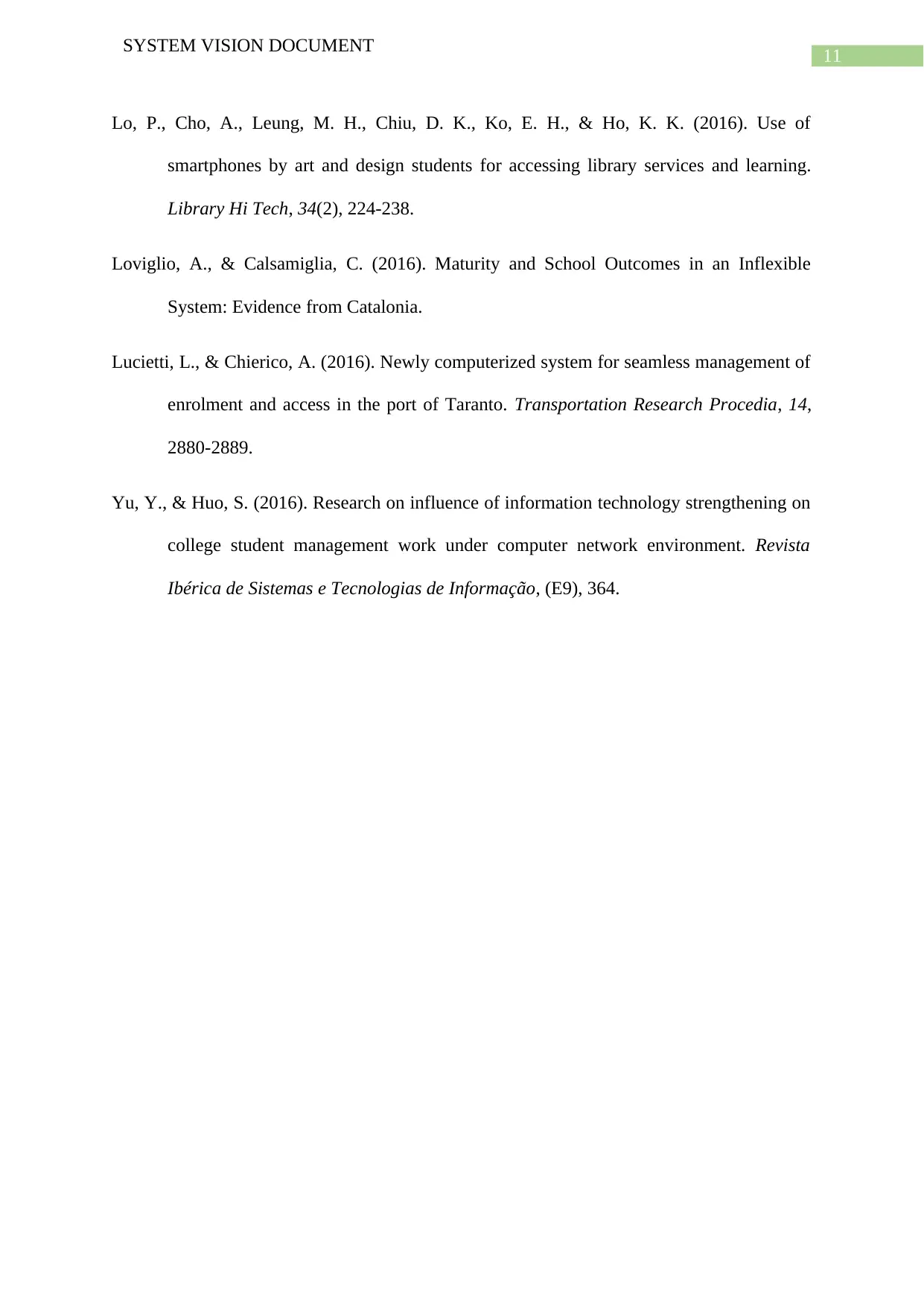
11
SYSTEM VISION DOCUMENT
Lo, P., Cho, A., Leung, M. H., Chiu, D. K., Ko, E. H., & Ho, K. K. (2016). Use of
smartphones by art and design students for accessing library services and learning.
Library Hi Tech, 34(2), 224-238.
Loviglio, A., & Calsamiglia, C. (2016). Maturity and School Outcomes in an Inflexible
System: Evidence from Catalonia.
Lucietti, L., & Chierico, A. (2016). Newly computerized system for seamless management of
enrolment and access in the port of Taranto. Transportation Research Procedia, 14,
2880-2889.
Yu, Y., & Huo, S. (2016). Research on influence of information technology strengthening on
college student management work under computer network environment. Revista
Ibérica de Sistemas e Tecnologias de Informação, (E9), 364.
SYSTEM VISION DOCUMENT
Lo, P., Cho, A., Leung, M. H., Chiu, D. K., Ko, E. H., & Ho, K. K. (2016). Use of
smartphones by art and design students for accessing library services and learning.
Library Hi Tech, 34(2), 224-238.
Loviglio, A., & Calsamiglia, C. (2016). Maturity and School Outcomes in an Inflexible
System: Evidence from Catalonia.
Lucietti, L., & Chierico, A. (2016). Newly computerized system for seamless management of
enrolment and access in the port of Taranto. Transportation Research Procedia, 14,
2880-2889.
Yu, Y., & Huo, S. (2016). Research on influence of information technology strengthening on
college student management work under computer network environment. Revista
Ibérica de Sistemas e Tecnologias de Informação, (E9), 364.
⊘ This is a preview!⊘
Do you want full access?
Subscribe today to unlock all pages.

Trusted by 1+ million students worldwide
1 out of 12
Related Documents
Your All-in-One AI-Powered Toolkit for Academic Success.
+13062052269
info@desklib.com
Available 24*7 on WhatsApp / Email
![[object Object]](/_next/static/media/star-bottom.7253800d.svg)
Unlock your academic potential
Copyright © 2020–2025 A2Z Services. All Rights Reserved. Developed and managed by ZUCOL.





